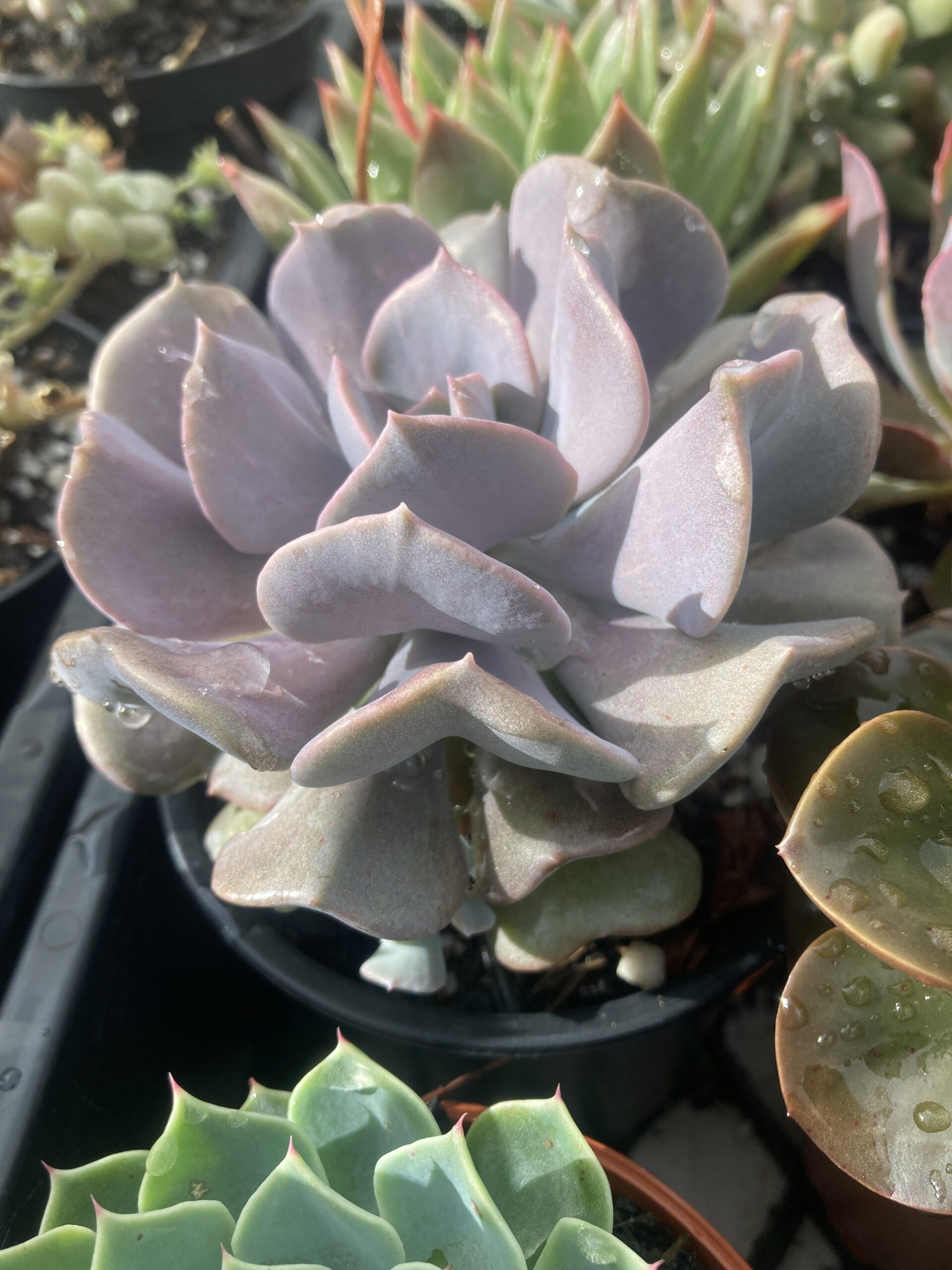Echeveria Cubic Frost is a fantastic hybrid that is both beautiful and hardy. The colour of this succulent ranges from grey blue to purple and can change throughout the year.
I have grown thousands of Echeveria Cubic Frost in my nursery and will share all the care tips for this wonderful plant below.
Description
Echeveria Cubic Frost is a succulent hybrid of other Echeveria (one parent is Echeveria ‘Doppler’ and the other is referred to as R-21) and was created by Renee O’Connell. It is also patented until 2035.
The result of this hybridization is quite stunning and also easy to grow succulent.
Echeveria Cubic Frost, like many other succulents change colour with the seasons. The brightest lilac-pink colour comes through in winter- early spring and then fades to greyish-blue, though the plant seems to retain some pink even in the warmer months. The intensity of the colour will largely depend on how much sun exposure the plant gets, how big the pot is etc.
The symmetrical leaf arrangement creates an attractive and somewhat quirky look, owing to the uplifted leaves. The centre of the leaf rises from the middle in an upturned V shape. The leaves have a softened appearance thanks to a generous dusting of protective layer called the farina. Farina acts as a sunscreen and protects succulents from suns’ UV.
Echeveria Cubic Frost grows to approximately 15cm in diameter, though can measure larger in ideal conditions. The rosettes stay quite low to the ground and only rise to about 12cms height.
Flowers appear in winter-spring and rise up on a tall, thick stalk. They are orange-pink in colour.
Position & Care
Echeveria Cubic Frost is quite a hardy plant and should be able to deal with direct sun exposure to about 35C/95F although, as with most succulents, it is recommended to provide shelter from strong sun during heatwaves as the leaves can burn. Morning sun/afternoon shade is the ideal position during a hot summer and full sun during the rest of the year to get that fabulous lilac colour.
Echeveria Cubic Frost, despite its’ name, is also not frost hardy and will need to be brought indoors once frosts are expected. It will, however, happily grow outdoors in low temperatures to about 1C/33F.
To get the best results, upgrade the pot once a year and plant in fresh succulent potting mix. If you live in a climate that often experiences hot summers avoid black pots as these will increase the heat around the root area.
Good quality succulent potting mix will ensure the plant is healthy and beautiful. Although Echeveria Cubic Frost is likely to grow in a generic potting mix it will not look as nice.
In the garden Echeveria Cubic Frost can be planted in a sunny spot and will be much more resilient than plants grown in pots. This means it will take higher temperatures and will not need watering as often.
Watering can be left to the rain, though do make sure to water well during heatwaves and droughts. A good rule is to water once the potting mix has dried up. Do not mist or spray and do not let the roots sit in a soggy potting mix.
Echeveria Cubic Frost is not suitable to be grown indoors unless it is in a sunroom, or under professional plant growing lights.
Propagation
Echeveria Cubic Frost can be propagated by offsets, leaves or seeds. The easiest and fastest method of propagation is by taking cuttings of offsets/chicks which form freely at the bottom of the rosette. Please note this succulent is patented and unauthorized propagation is illegal.
To successfully propagate offsets it is best to wait until they are big enough and have a substantial stalk that can be cut through. The cutting should then be left to dry for 24hrs and after that planted in succulent potting mix. For a guide on propagating succulents from offsets, you may want to read this article.
All propagating should be done during the growing season which is Spring and Summer. In moderate climates Autumn is good as well. My favourite time to propagate is Spring as it is not yet hot enough that the cuttings will burn. In summer during hot days cuttings and young plants can be a bit vulnerable to the strong direct sun.
Leaf propagation is extremely easy and Cubic Frost has a very high strike rate when it comes to leaf babies. The leaves are also easy to separate and Cubic Frost is, therefore, a perfect specimen for those who would like to try leaf propagation for the first time.
Seed propagation can be quite unreliable and extremely slow and thus I would not recommend going down this path.
Pests
Echeveria Cubic Frost is susceptible to all the usual succulent pests such as mealybugs, aphids and snails/slugs.
For a full list of pests and how to deal with them see our article on animals that like to eat succulents.
Toxicity
Echeveria Cubic Frost, just like all the other Echeveria, is not listed as toxic to humans, dogs, cats or other pets/ live stock. It is however not recommended to purposefully eat this plant.
Where Can I Get It?
Echeveria Cubic Frost has been around for a while and should be available in nurseries/ garden centres. Online nurseries are more likely to have one.
